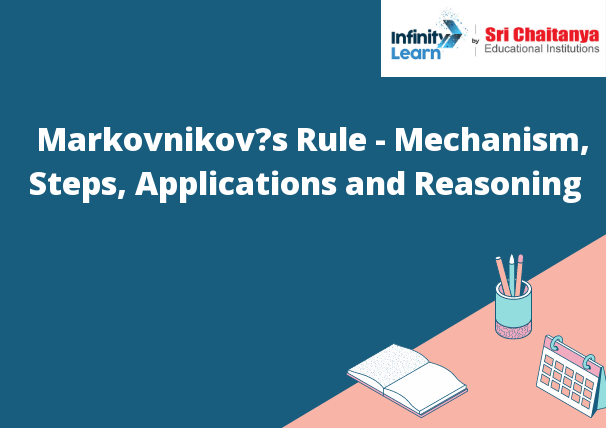Table of Contents
Introduction of Markovnikov’s Rule
Markovnikov’s Rule is a rule in organic chemistry that explains the orientation of addition of a hydrogen atom to an unsaturated carbon atom in an organic molecule. The rule is named after the Russian chemist Vladimir Markovnikov, who described it in 1869. The rule states that in the addition of a hydrogen atom to an unsaturated carbon atom, the hydrogen atom will always attach itself to the carbon atom that has the most hydrogen atoms already attached to it.

What is Markovnikov’s Rule?
Markovnikov’s Rule states that in the addition of a hydrogen atom to an alkene, the hydrogen atom will attach to the carbon atom that has the most hydrogens bonded to it.
Mechanism Behind Markovnikov’s Rule
The Markovnikov Rule states that in the addition of an unsymmetrical alkene (double bond) to a hydrogen halide (HX), the hydrogen attaches to the carbon atom of the alkene that has the greater number of hydrogen atoms already attached to it.
The mechanism behind the Markovnikov Rule is as follows:
- The hydrogen halide attacks the carbon atom of the alkene.
- The electrons of the double bond push the hydrogen atom towards the halide atom.
- The halide atom grabs the hydrogen atom and forms a bond.
- The carbon atom of the alkene is now left with a positive charge.
- The hydrogen atom that was pushed away from the carbon atom grabs a proton from the solvent to become neutral again.
Application of Markovnikov’s Rule in Other Reactions
- In the context of organic chemistry, the Markovnikov Rule states that the carbon of a double or triple bond with the most hydrogens will become the new carbon atom in the product of a reaction. The rule is based on the idea that the hydrogen-atom transfers (HAT) mechanism will occur preferentially. In this mechanism, the hydrogen atom that is most easily lost (the most acidic hydrogen) is transferred to the more electron-rich species. The electron-rich species is then able to undergo further reactions, forming the final product.
- The Markovnikov Rule can be applied to other reactions in addition to the addition of hydrogen atoms to a double or triple bond. For example, it can be used to predict the product of a substitution reaction. In a substitution reaction, one atom is replaced with another atom. In general, the Markovnikov Rule will predict that the atom that is most easily replaced (the most basic atom) will become the new atom in the product.
Reasoning behind Markovnikov’s Rule
The reasoning behind Markovnikov’s Rule is that the addition of the hydrogen atom to the alkene molecule is more likely to occur at the carbon atom that already has the hydroxyl group (-OH) than at the other carbon atom. This is because the hydrogen atom is more likely to add to the carbon atom that is already bonded to the oxygen atom in the hydroxyl group than to the carbon atom that is not bonded to any atom.
Facts about Markovnikov’s Rule
- Markovnikov’s Rule is a guideline for how to produce the most stable carbocation during a chemical reaction.
- The rule states that the hydrogen atom that is attached to the more highly-reactive carbon atom will be lost first in the reaction.
- The rule is named after the Russian chemist Vladimir Markovnikov, who first proposed it in 1869.
- The rule is widely accepted as a general principle in organic chemistry.
- There are some exceptions to the rule, but it is generally accurate.









